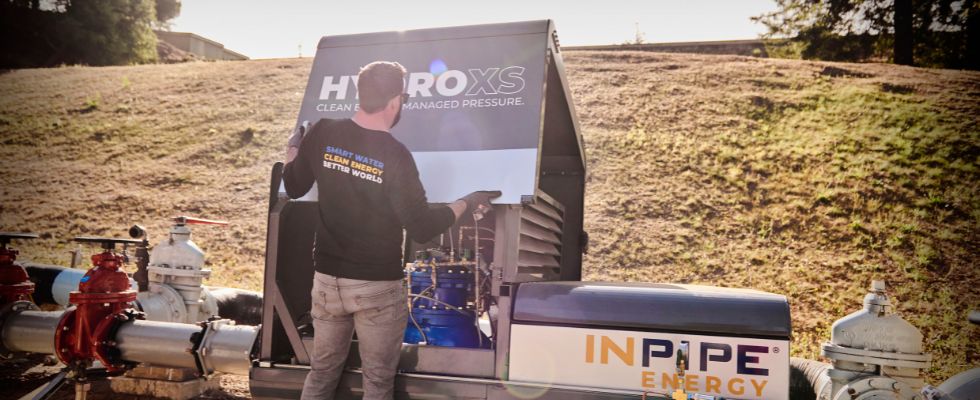
Nestled along the west coast between Seattle and the Canadian border, Skagit Public Utility District (PUD) operates the largest water system in Skagit County, Washington, providing nine million gallons of drinking water daily to its 85,000 customers. Like many rural water providers, Skagit PUD covers a broad service area, with over 600 miles of distribution pipeline serving county residents.
Skagit PUD consistently has to be creative with its funding. Minor changes to chemical, electrical and labor costs have an outsized impact on smaller districts’ budgets and long-term planning. Climate change also creates challenges for the community’s water sources, and the carbon footprint needed to deliver drinking water throughout this large service area is not lost on the district’s leadership.
Water-Energy Nexus
Skagit PUD captures raw water at Judy Reservoir, over 450 feet above its sea level users. After treatment, drinking water is sent downhill through massive transmission pipelines into the lower Skagit Valley. The downhill fall creates immense pressure, most of which is attenuated through typical pressure reducing valves (PRV) to avoid leaks and damage to pipes and homes.
As the district’s population grows, demand on its treatment system to pump more water increases operational costs and is compounded by increasingly higher electricity rates. The resulting convergence of demand and cost leads energy to continuously claim more of the district’s budget. With eco-conscious ratepayers nationwide asking water providers what they are doing to limit their carbon emissions footprint, the district felt itself moving in the wrong direction.
When the time came to replace a critical PRV at the district’s East Division Street pump station, Skagit PUD took the opportunity to consider how a change in operations or infrastructure could turn the tide on its increasing electric bills and resulting greenhouse gas emissions. After researching water-energy products, they discovered a PRV that converts historically wasted pressure and heat into renewable energy.
Funding the Future
Investing in innovative solutions can be challenging for rural water providers, who are typically cautious of new technology and too underfunded to buy the latest. Skagit PUD wanted to push the envelope but needed help to make the change. The district applied to federal energy efficiency grants and local power authority initiatives. Piecing these funding sources together, the district invested in its future.
Micro-Hydro Power
Water is conveyed through miles and miles of pipelines under pressure. This pressure is typically burned off through control valves. Control valves use friction, like brakes in a car or crimping a hose, and burn off pressure. This pressure has previously been wasted. Now, this once-wasted pressure can generate renewable energy without sacrificing pressure management or accuracy. Skagit PUD was the first utility in Washington state to pilot a micro-hydroelectric-based control system that converts water flow and pressure into electricity. It integrates flange to flange to a new or existing water pipe. The system seamlessly complements traditional control valves, tapping into potential energy to create a more predictable way to generate carbon-free electricity.
Water inlet
The process begins with the inflow of water, which can come from various sources, such as a water distribution system, a wastewater treatment plant or an industrial process.
Micro-hydro turbine
A micro-hydro turbine is designed to rotate when pressurized water flows through it. As the water enters, the flow and the pressure of the water spin the impeller in the turbine.
Electricity generation
An alternating current (AC) generator is connected to the impeller’s shaft, where the impeller’s energy is transferred. The generator converts mechanical energy into electrical energy through the principles of electromagnetic induction. As the impeller rotates, it turns the generator, producing an electrical output that can be used or fed into the electrical grid.
Output & Storage
The generated electricity can be used immediately to power nearby equipment or can be stored in batteries. It can also be integrated into a larger grid for distribution.
Equipped with funding and the manufacturer’s technical support, Skagit PUD added pipe hydroelectricity at its existing pressure reducing valve to offset the East Division Street pump station’s energy demand.
Pressure Relief & Energy Recovery
In July 2021, Skagit PUD completed the East Division Street Energy Recovery Project at its booster station in Mount Vernon.
Over the past three years, the 22-kilowatt (kW) system has generated up to 104,000 kilowatt-hours (kWh) of electricity annually. The electricity produced offsets the grid power at the pump station, replacing the equivalent of 3.5 million pounds of carbon emissions every year and a projected 728 tons over its 30-year life span. The electricity savings will achieve a payback in under 10 years for the district.
The operational and budgetary benefits from the East Division Street Energy Recovery Project convinced the district to continue identifying high-pressure point opportunities in its distribution line. Leveraging the same funding sources,
Skagit PUD has kicked off another hydroelectric project at the high school in Mount Vernon. This site will use the same technology as the East Division Street project, but more than twice as much electricity is predicted—over 290,000 kWh of renewable energy from otherwise wasted pressure. The system will also be providing power for electric vehicle charging stations and may avert up to 9.3 million pounds of CO2 emissions in its lifetime.
Leading the Way
Skagit PUD made small changes that have proven transformative to its energy and water conservation goals. The East Division Street Energy Recovery Project underscores the feasibility and impact that water providers, big and small, can have on both climate change and their communities’ water rates.
As environmental and economic pressures squeeze small- and medium-sized water utilities, creatively using federal, state and local energy grants to fund water infrastructure improvements can put innovation within reach. Combining these funds with innovative technologies and the will to incite change, any organization that pumps water can follow Skagit PUD’s example to combat climate change and the cost of pumping and treating water.

